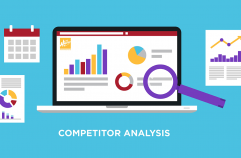What is KPI in SEO?
KPI in SEO stands for “Key Performance Indicator” and refers to specific metrics that help measure the success and effectiveness of SEO efforts. These metrics include website traffic, rankings, conversion rate, click-through rate, dwell time and others that help gauge how well the website is performing in search engines and how well it is meeting the goals set for the SEO strategy. KPIs are used to track progress, identify areas for improvement, and make data-driven decisions to optimize the website’s visibility and performance in search engines.
- Organic Traffic KPI refers to the metric that measures the number of visitors who come to a website from organic search results, rather than from paid advertising or other sources. It is considered a key performance indicator in SEO as it reflects the effectiveness of the website’s search engine optimization efforts in attracting and retaining visitors. A higher volume of organic traffic typically indicates a higher level of visibility and relevance in search engines, which can lead to better rankings and increased brand awareness. The goal of increasing organic traffic through SEO is to drive more targeted, high-quality traffic to the website, which can improve its overall performance and meet the business’s marketing and sales goals.
- Keyword Rankings KPI refers to the metric that measures the position of a website’s pages in search engine results pages (SERPs) for specific keywords or phrases. It is considered a key performance indicator in SEO as it reflects the website’s visibility and relevance for targeted search terms. Higher rankings for targeted keywords can lead to increased organic traffic and visibility, as well as better engagement and conversion rates. Tracking keyword rankings helps SEO professionals understand how well their optimization efforts are impacting search visibility, and identify areas for improvement. Additionally, changes in keyword rankings can provide insight into the impact of algorithm updates, competitor activity, and other factors that can affect search performance.
- Bounce Rate KPI refers to the metric that measures the percentage of visitors to a website who leave after only viewing a single page. In other words, it indicates the number of visitors who “bounce” away from the website after visiting just one page. Bounce rate is considered a key performance indicator in SEO and web design as it provides insight into the effectiveness of a website’s content, navigation, and user experience. A high bounce rate suggests that the website is not providing a good user experience or that it is not relevant to the visitor’s search query. In contrast, a low bounce rate indicates that the website is meeting the needs of its visitors and providing a positive experience. Improving the bounce rate can help increase engagement, improve conversion rates, and drive more organic traffic to the website.
- Conversion Rates in SEO KPI refer to the metric that measures the number of visitors to a website who take a desired action, such as making a purchase, filling out a form, or subscribing to a newsletter. It is calculated as the ratio of conversions to total visitors, expressed as a percentage. Conversion rate is considered a key performance indicator in SEO as it reflects the effectiveness of a website’s overall user experience, content, and design in driving desired actions from its visitors. A higher conversion rate suggests that the website is effectively meeting the needs of its visitors and driving them to take the desired action, while a low conversion rate may indicate that the website needs improvement in areas such as user experience, content, or conversion optimization. Improving conversion rates through optimization and testing can have a significant impact on the success of an SEO strategy, helping to drive more sales and revenue.
- Time on Site SEO KPI refers to the metric that measures the average amount of time that visitors spend on a website during a single session. It is calculated as the total time spent on the website divided by the number of sessions. Time on site is considered a key performance indicator in SEO as it provides insight into the engagement and relevance of a website’s content for its visitors. A higher time on site suggests that visitors find the website’s content valuable and engaging, while a low time on site may indicate that the website is not providing the information or experience visitors are looking for. Improving time on site through optimization and testing can help increase engagement, reduce bounce rate, and drive more organic traffic to the website. Additionally, longer time on site can also help improve search engine rankings, as search engines use user engagement metrics, such as time on site, as a factor in their ranking algorithms.
- Pages per Session SEO KPI refers to the metric that measures the average number of pages that visitors view during a single session on a website. It is calculated as the total number of pages viewed divided by the number of sessions. Pages per session are considered a key performance indicator in SEO as it provides insight into the depth and breadth of engagement that visitors have with a website’s content. A higher page per session suggests that visitors are exploring the website and engaging with its content in a more profound way. In contrast, low pages per session may indicate that the website’s content is not relevant or engaging enough to keep visitors interested. Improving pages per session through optimization and testing can help increase engagement, reduce bounce rate, and drive more organic traffic to the website. Additionally, a higher number of pages per session can also help improve search engine rankings, as search engines use user engagement metrics, such as pages per session, as a factor in their ranking algorithms.
- Backlinks SEO KPI refers to the metric that measures the number and quality of links pointing to a website from other websites. Backlinks, also known as “inbound links” or “incoming links,” play a crucial role in search engine optimization as they signal to search engines the quality and relevance of a website’s content. A high number of high-quality backlinks from reputable sources can help improve a website’s search engine rankings and visibility, while low-quality backlinks or a large number of spammy links can harm the website’s search performance. Backlinks are considered a key performance indicator in SEO as they provide insight into the popularity and authority of a website, and can be used to track progress and identify opportunities for improvement. Additionally, changes in the number and quality of backlinks can also indicate the impact of algorithm updates, competitor activity, and other factors that can affect search performance.
- Social Shares KPI refers to the metric that measures the number of times that content from a website is shared on social media platforms, such as Facebook, Twitter, and LinkedIn. Social shares are considered a key performance indicator in SEO as they provide insight into the engagement and popularity of a website’s content, as well as its reach and visibility beyond the website. A high number of social shares can help increase the visibility and credibility of a website, as well as drive more traffic to its pages. Social shares can also impact search engine rankings, as search engines may use social signals, such as shares and likes, as a factor in their ranking algorithms. Tracking social shares can help SEO professionals understand how well their content is resonating with their target audience and identify opportunities for improvement. Additionally, changes in social shares can also provide insight into the impact of algorithm updates, competitor activity, and other factors that can affect search performance.
- Mobile optimization refers to making a website or web application easily accessible and usable on mobile devices such as smartphones and tablets. This includes optimizing the layout, design, and functionality for smaller screens, as well as ensuring fast load times and minimal data usage. Mobile optimization is important because a growing number of internet users access websites on mobile devices, and a poorly optimized website can result in a poor user experience, lower engagement, and decreased conversions.
- Content performance refers to how well a particular piece of content (such as a blog post, video, image, etc.) is performing in terms of metrics such as engagement, reach, and conversions. The performance of content can be analyzed using tools such as Google Analytics, social media analytics, or custom tracking systems to determine factors such as:
a. Views: The number of times a piece of content has been seen.
b. Engagement: The level of interaction with the content, such as comments, likes, shares, or clicks.
c. Bounce rate: The percentage of visitors who leave the website after viewing only one page.
d. Conversion rate: The percentage of visitors who take a desired action, such as making a purchase or filling out a form.
Understanding the performance of the content is important for businesses and marketers as it helps them to make informed decisions about what types of content to create and promote, and how to optimize their content for maximum impact.




